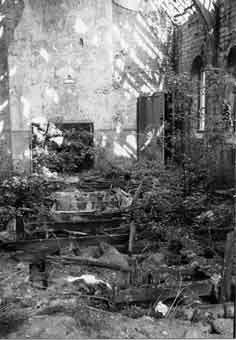|
Index
(Albert's page numbers in brackets) |
| Page 1 (1-3) |
| Page 1a (3-4) |
| Page 2 (4-7) |
| Page 3 (7-10) |
|
Page 4 (10-13) |
| Page 5 (13-15) |
| Page 6 (16-17) |
| Page 7 (18-20) |
| Page 8 (21-24) |
| Page 9 (25-27) |
| Page 10 (28-29) |
| Page 11 (30-31) |
| Page 12 (32-33) |
| Page 13 (34-35) |
| Page 14 (36-37) |
| Page 15 (38-39) |
| Page 16 (40-41) |
© 2010 Paul Stokes
Drakelow
The Diaries
of Albert Fowler Continued.....
|
BACK Camoflage is a sort of security measure. An underground factory shows little sign on the surface to indicate a thriving industry below. Near 100% secure from enemy detection or attention. The unexpected can and does occur to upset carefully thought out camoflage. February 1944 gave us an exceptional spell of fine weather. For a week the temperature rose for a few hours around midday into the 70's. After dinner in the Canteen at midday, almost the whole works personnel made its way up-top to sit or lie, on the sandstone hill and bask in the glorious sun. (In winter we often didn't see daylight for a week). The presence of masses of people in a place where none should be (a dead give away) was reported to security who clamped down immediately by putting the hill out of Bounds. The nights were bitterly cold with sharp frosts. A typical winter high pressure system.
Nurse Vowden from our Surgery, who was on duty with the Transfusion Service, came from the Channel Isles, getting away from there just before the Germans occupied them. Her Father was a wealthy Banker and stayed on. Gibbons, the Tunnel Engineer swore he was a Quisling. Vowden certainly looked the typical Big Blond German fraulein. Sour grapes on Gibbons part? Rumour hath it, his advances met with little response. Another Jersey-ite Len Heywood worked at the Airport. After helping load up the last plane to leave the island he scrambled aboard. Who could blame him, he had no family ties. Of military age it was either the Prison camp or forced labour for him. Nurse Vowden heard from time to time via the Red Cross how her family were getting on. Some nurse !! I saw her examine a pimple on a patients face "We'll have to take the top off that" and she did so, with her finger nail. I always got on well with her. She would nobble me for a waltz at evening dance time. I learned with great sadness of the death of my Wythalls chief Civil Defence Officer Major F.C. T.Hadley, at the age of 60 yrs. Major Hadley was a leader one could trust. A man of vast experience with activities and interests over a wide field. His Obituary in the Redditch Indicator (Nell cut it out and sent it to me) filled a column. I'm glad the 'Old Brigade' turned out to pay homage to him. It was a pleasure to have known him and to have served under his leadership. Wythall was the poorer for his passing.
|
|||||||
![]() Back
to home page
Back
to home page ![]() Drakelow
Unearthed
Drakelow
Unearthed
© All photographs on this site
are protected by copyright law.
They
may not be reproduced in any form or location electronically or in print
without prior written permission from the copyright owner.


